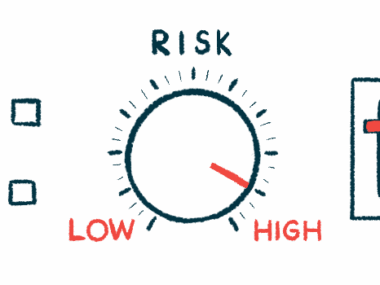AAV combo therapy allows for early glucocorticoid withdrawal
Cyclophosphamide-rituximab treatment found effective in new study
Written by |

Induction therapy with cyclophosphamide and rituximab allows for early discontinuation, without compromising efficacy, of an oral-only glucocorticoid regimen in people with severe ANCA-associated vasculitis (AAV), a study found.
Patients on oral glucocorticoids for up to three months showed comparable remission and relapse rates, but tended to have fewer infections compared with those given these medications for more than three months, the researchers noted.
Long-term use of glucocorticoids is associated with serious side effects, and these findings suggest that early withdrawal may be safely achievable with this treatment combination.
The data also suggest that intravenous (into-the-vein) methylprednisolone, a glucocorticoid treatment regimen commonly used before an oral glucocorticoid taper, “may be unnecessary in the early management of AAV,” the researchers wrote.
Standard initial use of intravenous methylprednisolone “not only increases cumulative glucocorticoid exposure, but is also associated with an increased risk of infection and diabetes,” the team added.
The study, “Combination cyclophosphamide and rituximab to minimize glucocorticoid use in Antineutrophil Cytoplasm Antibody-Associated Vasculitis,” was published in Kidney International Reports.
Patients with more severe kidney damage showed greatest improvement
AAV is a group of autoimmune disorders characterized by inflammation and damage to small blood vessels, which can potentially harm various organs, most commonly the kidneys, and cause a wide range of symptoms.
Treatment for AAV typically involves high-dose intravenous glucocorticoids followed by oral glucocorticoid tapering to induce and maintain remission. This is done in combination with immunosuppressive medications like cyclophosphamide or rituximab.
Given glucocorticoids’ associated risk of serious side effects, there is a great interest in identifying therapeutic approaches that reduce their use. Previous research suggests that lower-dose glucocorticoid regimens can be used and successfully tapered during the induction phase without compromising treatment effectiveness.
However, “there remains uncertainty about the optimal duration of glucocorticoid therapy,” the researchers wrote.
Now, a team of researchers in Scotland retrospectively analyzed the long-term outcomes of 112 people with severe AAV who were treated with cyclophosphamide-rituximab induction, but no intravenous glucocorticoid, alongside a rapid oral glucocorticoid taper.
These patients were treated at the Edinburgh Vasculitis Service between 2011 and 2023. Most had newly developed disease, while 12% were experiencing disease relapse.
There remains uncertainty about the optimal duration of glucocorticoid therapy.
Regarding AAV types, 52% had microscopic polyangiitis, 43% had granulomatosis with polyangiitis, and 5% had eosinophilic granulomatosis with polyangiitis, known as EGPA. Most patients (85%) had kidney involvement.
The tapering and withdrawal of prednisolone, the oral glucocorticoid used, were tailored to each patient to minimize exposure while maintaining disease control. Rituximab was used as maintenance treatment in 89% of patients.
Most participants (96.4%) achieved disease remission after a median of 77 days (about 2.5 months). Five patients experienced relapses over a median follow-up of 2.9 years.
Blood levels of AAV-driving antibodies, called ANCAs, and of CRP, a marker of inflammation, showed an early and sustained reduction.
Kidney function improved significantly over one year as reflected by such widely used measures of kidney function as lower blood creatinine levels, higher estimated glomerular filtration rate (eGFR), and reduced urine protein-to-creatinine ratio
Patients with more severe kidney damage at the study’s start showed the greatest eGFR improvements after treatment. Follow-up kidney biopsies also confirmed a reduced risk for future kidney failure relative to the study’s start, per the data.
No major differences between shorter, longer treatment groups
The median duration of prednisolone treatment was 12.5 weeks, or about three months, with a median total dose of 1,780 mg. Patients treated with oral glucocorticoids for up to 12 weeks received a significantly lower cumulative dose relative to those on longer treatment (1,133 mg vs. 2,935 mg). All EGPA patients received longer prednisolone treatment.
No significant differences were seen between the shorter and longer treatment groups in terms of remission rate (91% vs. 100%) and relapse rate (0% vs. 9%). Kidney recovery was also comparable between groups.
“However, the time to disease remission was shorter in patients receiving [up to] 12 weeks of glucocorticoid therapy,” the researchers wrote.
Although longer treatment involved higher glucocorticoid exposure, no increase in mortality or overall adverse events was observed. Still, a shorter prednisolone regimen was associated with a trend toward fewer serious infections relative to a longer regimen (7% vs. 21%).
Among the study’s limitations, the team noted that glucocorticoid tapering and withdrawal were not standardized, and that while initial characteristics were similar between shorter and longer glucocorticoid groups, unmeasured factors may have influenced the results.
“However, our data suggest that some patients may be able to stop glucocorticoids earlier than the guidelines currently recommend,” the researchers wrote.
Overall, these results shed light on “both the need for [intravenous] glucocorticoids and the optimal duration of oral glucocorticoid therapy in patients with severe AAV,” the team concluded. “Future [appropriately controlled] trials are warranted to confirm these findings and explore even lower glucocorticoid doses or alternative immunosuppressive combinations that may further mitigate treatment-related morbidity.”







